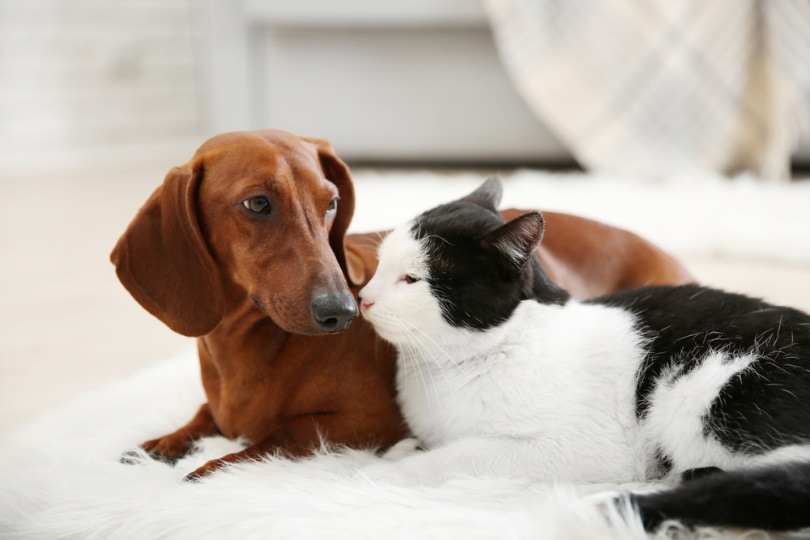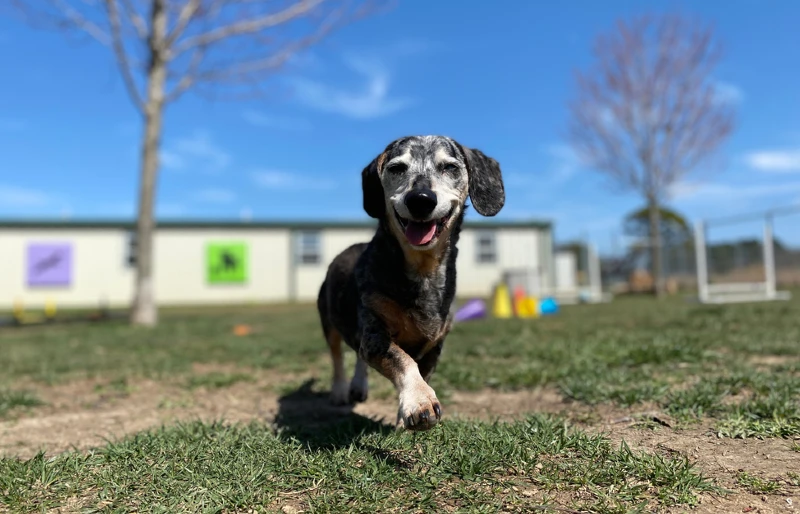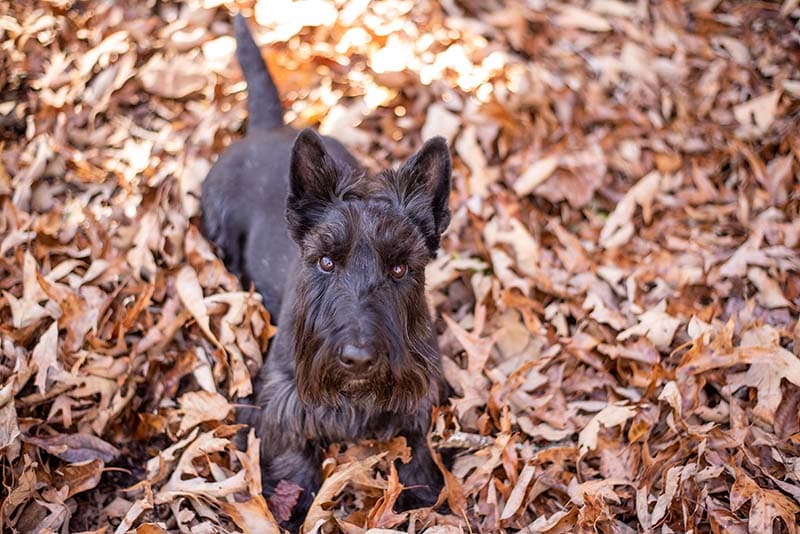Dachshund Dog Breed Info: Pictures, Traits & Facts

Updated on

| Height: | 8 – 9 inches |
| Weight: | 11 – 32 pounds |
| Lifespan: | 12 – 15 years |
| Colors: | Black, red, cream, brown, sable, pied, brindle, grey, fawn |
| Suitable for: | Companionship to singles or seniors; families with older kids |
| Temperament: | Feisty, willful, vocal, alert |
The Dachshund is a member of the scent hound family, bred in Germany in the 1500s. These dogs were famously described by H. L. Mencken to be “a half-dog high and dog-and-a-half long.” The AKC ranks them 12 in popularity out of 196 breeds.
The Dachshund, pronounced DAKS-hund, comes in two different sizes in America: miniature and standard. The miniatures weigh 11 pounds or less as an adult dog. Standard Dachshunds weigh 16 to 32 pounds. If your pup is an adult and weighs in between these two, they are called a Tweenie.
In other parts of the world, there are different standard sizes. Germany, the Dachshund’s birthplace, has three accepted sizes, including the Kaninchenteckel, miniature, and standard. All of these are based on measuring the pup’s chest at 15 months old.
Dachshunds are cute dogs that love to be the center of attention in any group. They are confident dogs with good intelligence. The combination makes them willful, so they are not the best dog for a first-time owner.
They are also called wiener dogs, Doxies, sausage dogs, Teckels, and more.
Dachshund Puppies

The price of Dachshund varies due to several factors, including supply and demand. There are also so many different options when picking the color, coat texture, and size of a Dachshund. Some of them are markedly more popular than others, and these cost much more.
The more popular the coat and color, the more expensive the dog will be. The typical color patterns include brindle, sable, and dapple.
There are also other colors and patterns that you can find in Dachshunds, like double dapple, piebald, and brindle piebald. Be aware that some of these dogs suffer from more health problems, including being born with missing eyes. The one to watch out for is double dapple.
The other factor to consider with these dogs is that they are purebred, and dogs with a better pedigree often have higher price tags. If you want to register your pup as a show dog, make sure to check that their size and color qualifies them to enter.
3 Little-Known Facts About the Dachshund
1. Dachshund in German means “badger dog.”
The Germans originally bred the Dachshund. They had a goal to create a dog that was small and long with a fearless spirit. Although most Dachshunds are not used for hunting today, they have kept their tenacity.
Foresters and huntsmen were most focused on succeeding at breeding a dog to deal with badgers. They would be sent down into a badger’s burrow to kill it.
This is why they have a proclivity to dig, making short work of any obstacle on their way to the goal.
After they had killed the badger, they would bark loudly. Their bark has stayed with them to this day, being deep and at high volume. When the gamesmen would hear this, they would come and help pull the dog out of the burrow, along with the badger.
There were a variety of dogs used to breed the Dachshund. They were a cross between Spaniels and Terriers, with some French Basset Hound, Braque, and Pinscher. Together, the Dachshund was created with long bodies, loud vocal cords, courageous spirits, and a high prey drive.
2. Dachshunds have had complicated histories of rises and declines in popularity.
The Dachshund’s heavy association with their birthplace, Germany, meant that they were in for a rough future. It was in the 1500s that the dogs were initially bred. Then, in the 1800s, they began to be popular as pets, and thus the miniature version was born. They spread throughout Europe as more people began to move between countries and kingdoms. One such nation was England, where they grew to be a favorite pet of Queen Victoria. Her favoritism created a boom in their overall popularity.
The Dachshund was initially brought to America in 1870 to hunt rabbits. It was first registered with the American Kennel Club in 1885, among some of the first breeds to be recognized after the club’s formation. The German Kennel Club accepted it, only after the AKC did, in 1888.
Everything was looking up for this breed until World War I began. Anything associated with the Germans quickly fell in popularity, and breeders stopped breeding these dogs. It would last for a couple of decades until the dog began to regain its footing in American households. However, once it did and World War II occurred, the Dachshund had a solid hold in American’s hearts, and it did not go through as big of a struggle.
3. A Dachshund’s back needs to be protected so they stay healthy for as long as possible.
Anyone can see that a Dachshund does not have the same form typical to other dogs. They are durable, lean, and long, but they still need proper care to help them live a long, healthy life.
Health issues that these pups can suffer from are related to their back. Spinal and vertebral problems can cause them to have a rough life as they age. To protect their back, make sure that when you hold them that you support their back paws. Doing what you can to keep their back in proper alignment involves more care than it would for other dogs.
Keep an eye on their weight as well. Dachshunds that do not receive enough exercise quickly add on the pounds. Since most of this focus right underneath the center of their back, it can cause extra strain to be put on those muscles and bones.
Dachshunds can hurt their backs jumping off or onto higher surfaces. To protect them this way, put doggy stairs around the home or ramps. Do training sessions to teach them to use it. This way, they don’t bend or flop down in a way that injures them.

Temperament & Intelligence of the Dachshund 🧠
Dachshunds are a lovely breed with an elongated face, short legs, and alert, watchful eyes. They bond quickly with their family from a young age. Engage in bonding activities to try and form a strong tie between you and your Dachshund.
The overall attitude of these dogs can be hard to pinpoint. They can have rather snappy tendencies and short fuses. They can also be shy, though that tends to be uncharacteristic of these fearless, vocal dogs.
Wirehaired Dachshunds have Terrier breeds in their old bloodlines. This ancestor gave them a trouble-making streak and can have a personality that is demanding and obstinate. Long-haired pups don’t have the more difficult breeds in their lineage. They tend toward quiet and calmness, best for being a companion dog, especially for seniors. Smooths have a personality that lies between the two.
When you pick your puppy, watch for those with a curious temperament, those who want to play, and those who are happy to approach people and interact. One of the more significant problems with this breed is their issue with human strangers.
If you tend to have many people in your home, try to make sure your dog will behave appropriately. Meeting their parents, especially the mother dog, can help you realize the breed’s adult potential.
Are These Dogs Good for Families? 🏡
These dogs are not the best choice for families with small children. Since they don’t tend to have much patience and can have a standoffish temperament, they need people around them who know how to treat them. Younger children shouldn’t hold these dogs because it can damage their spines.
If your family has an older age overall, these can be sweet pets with a great deal of character and intelligence. They make excellent companions and will generally pick one or two people to have a strong bond within their household.
They are also good watchdogs for a family home. Dachshunds are always alert and ready to bark at anything. They have unusually large lungs for their size, giving them their deep chest and loud bark. With the right training, they know just what to do when an intruder approaches your home.
Does This Breed Get Along With Other Pets? 🐶 😽
Dachshunds can get along with other pets if they have more of an approachable temperament. They need to be socialized earlier in their lives and frequently. They might be aggressive toward other dogs if they have not been properly trained to handle new animals.

Things to Know When Owning a Dachshund
Food & Diet Requirements 🦴
A Dachshund does not need a large amount of food each day. Feed your Dachshund between ½ to 1½ cups of food a day. Keep their weight in check and don’t allow them to free feed. Find dog food that is high quality and has increased ingredients to support joint and bone strength.
Their daily food requirements are dictated by their age, size, activity level, and metabolism. Consider all of these, and adjust accordingly as your dog goes through different life cycles and stages. Talk to your vet to ensure that they are receiving the right amount of food and the best type.
Exercise 🐕
Since Dachshunds were bred for running and digging, the Dachshund is a naturally active dog. They like to play, so taking them to the dog park is a great way to socialize and burn some energy.
Don’t be surprised if your Dachshund has a behavioral problem around digging. It can be hard to train this out of them, so some owners opt to keep them in the house or under only supervised yard visits. They do well in small homes and apartments because they are small, but the owner needs to ensure that they receive enough exercise.
Be watchful during activity and exercise because it can be difficult for them to realize the consequences for their backs. Don’t allow them to jump off of anything or climb around.
Dachshunds should receive a couple of 30-minute walks a day. Walking them an average of 7 miles each week should be enough to keep the pounds off and their metabolism high.

Training 🦮
Dachshunds are challenging to train most of the time. They need a trainer with a firm hand and a solid understanding of stubborn, temperamental dogs.
Housetraining can be a problem at times. They seem to simply not understand why it is a problem to go to the bathroom inside the home. The keys to training these dogs are patience and consistency.
Another aspect of their training sessions is proper motivation. They are intelligent pups and only want to do things that they have an interest in. If they become bored, they quickly move on to whatever is most impressive.
Grooming ✂️
No matter what type of coat your Dachshund has, they don’t shed excessively. Smooth Dachshunds need the least amount of grooming because their coat grows short and close to their bodies. Wirehaired Dachshunds need regular brushing, and once or twice a year, they should be stripped.
The long-haired variety of this breed needs the most amount of grooming to avoid tangles and mats in their fur. They should get more baths than the other two, although still not often, and blow-dried afterwards.
Other than maintaining their coat, they need special attention when it comes to their ears. Dachshunds have droopy ears that are relatively close to the ground, so they are breeding grounds for mites and fungus. Clean them out to get rid of these, as well as bacteria.
Trim their nails a couple of times a month to keep them in good condition, and brush their teeth daily for maximum dental hygiene.
- See Also: 11 Best Dry Dog Shampoos
Health and Conditions ❤️
Taking your Dachshund for regular veterinary appointments is essential to maintaining the overall wellness of this breed. They need their spine checked and regular checks on their eyes as well.
Not all Dachshunds are guaranteed to suffer from the diseases that are most common to these dogs. But as they get older, schedule more veterinary appointments to catch any serious issue as soon as possible.
- Intervertebral disc disease
- Bloat
- Progressive retinal atrophy
- Epilepsy
- Deafness
- Diabetes
- Cushing’s disease
Male vs. Female
There are not many differences in the personality traits of the male and female Dachshund.
Final Thoughts
These dogs are an iconic image of what it is to be a purebred pup. They seem to be proud of their heritage, standing perky and tall regardless of their stature.
When it comes to a Dachshund, there are enough colors and sizes for anyone’s preferences. Their antics and mischief never cease to amaze (and sometimes irritate) people. But when they turn their adorable faces to you, you can’t help but love them.
The Dachshund might not be the right choice for everyone because they are more difficult to train than some. They are not the best choice for families with small kids, but they make wonderful pets for older families or as a quirky companion dog.
If you are ready for a dog with a feisty personality that can be an incredible friend, then the Dachshund should be at the top of your consideration list.
See also:
- 8 Best Pet Insurance Providers for Dachshunds – Reviews & Top Picks
- Male vs Female Dachshund: How Are They Different?
Featured Image Credit: Masarik, Shutterstock













